Yesterday evening, we were photographing Snow Geese and didn’t realize that we (along with at least 10 other photographers) had chosen a field where hunters were lying in camo. I promised myself I would wait until hunting season as I did last year. But, we were in the area, and we heard the clamor of a Snow Goose flock. I listened for shotguns — all was quiet. With just 20 minutes before the end of shooting hours, I thought we were clear. But, it’s the last weekend of waterfowl hunting season here in Washington, so I should have known better.
Most of these photos aren’t graphic — they are too distant and dark to be graphic. But, I have a few images of a hunter retrieving an injured bird. Don’t click through if this will bother you. It certainly troubles me deeply to witness it in person … every time.
We photogs were lined up on a rural road, most of us using our cars as blinds — catching the last rays on the white plumage of Snow Geese. In my experience, Snows in this area aren’t fazed by photographers. And, a lot of birds are calm around automobiles as blinds. As we clicked our shutters, squadron after squadron of Snow Goose burst over the peaks of Devils Mountain, then flapped to a halt in this field, to graze on the greens.

The last group of geese flew toward us, then — boom, boom, boom! — multiple blasts. Geese tumbled to the ground. Shotgun fire is a rancor I’ve come to identify with my worst moments in my life. It shatters the natural silence and always brings on disruption and chaos, death and injury.
Flushed by the hunters, the Snow Geese erupted in their characteristic way, then swarmed toward us, away from the area where the hunters sprang from their camo trenches.

The hunters walked away with a few injured geese which they promptly killed and carried off the field. They sometimes call the process of killing a bird by hand “helicoptering.” If you don’t know what that is, I’m sure you can figure it out.

But they left one wounded juvenile goose standing in the field. From what I could tell through my telephoto, the goose was bleeding around its legs and backside. As his flock-mates moved toward us and away from the trenches, this goose was immobilized in the background, as this photo shows.
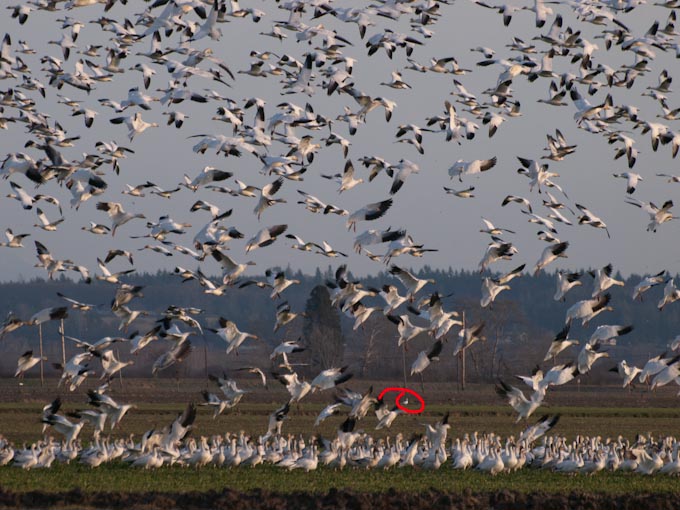
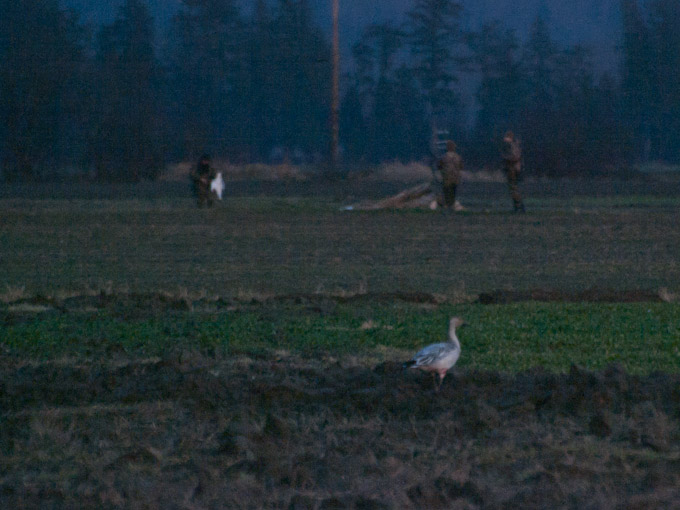
I am hard-wired to help animals. I avoid hunting areas because of this very thing … because, more often than not, there’s little I can do except stand by helplessly as animals fall injured. It is pure agony to witness.
Almost every state has hunter harassment laws that penalize persons who interfere in any way with a hunt. This precludes retrieving fallen birds that are still alive on a hunter’s turf, or rescuing an animal dying slowly from a bowhunting wound as the hunters wait out the poor being’s demise. Still, we opted to stay and watch for stranded geese. We had our mud boots and some rescue gear, determined not to leave any disabled birds behind (known by hunters as “cripples” or “crips.”)
Hunters, legally, can’t shoot toward the road where we photographers were standing. So, after the last flush-and-landing, the geese were now grazing safely out of range, near our cars. With the birds at our sides, the risk of flushing them toward the hunting trenches was too great to do anything but remain steady and innocuous.
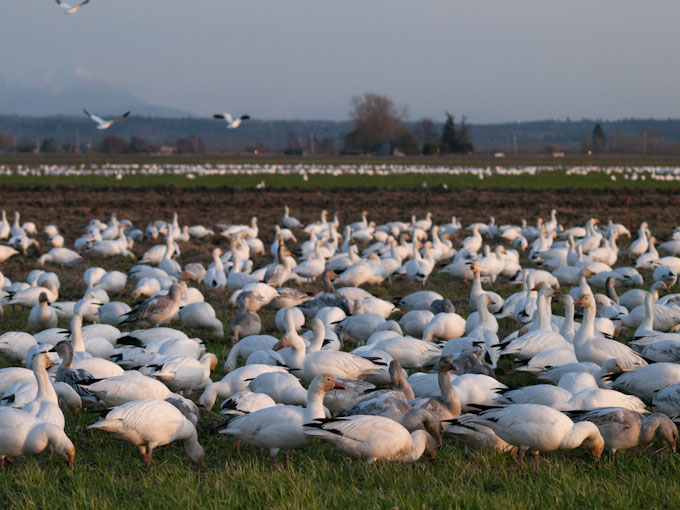
For reasons only Snow Geese can identify, they burst into whirlwinds of flight at various provocations. Some of those are obvious, like shotguns. Others are more subtle … distant aircraft engines or raptor calls, human snow-goose calls, and probably a host of other stimuli of which I’m not aware. So, although the air seemed silent to me in the aftermath of the hunt, to the Snow Geese it wasn’t. At once, they raised their necks in alert and promptly flushed again to the far side of the field, away from the hunters.
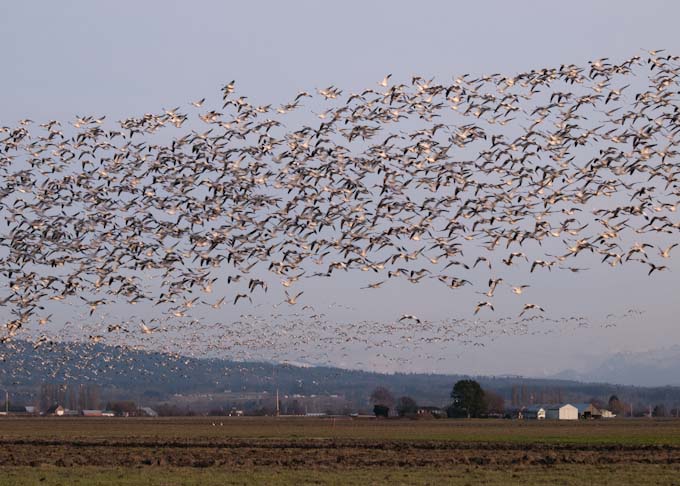
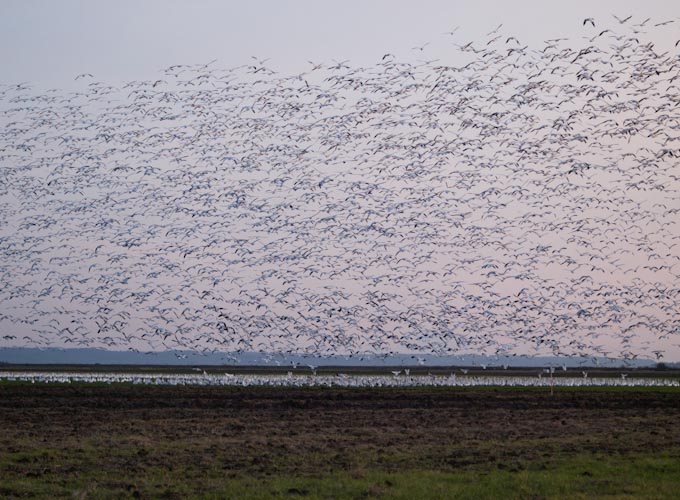
But, again, as they fluttered down to the field, wings and feet poised for landing, shotguns boomed even louder to our right, in the area of the field where the geese were landing.
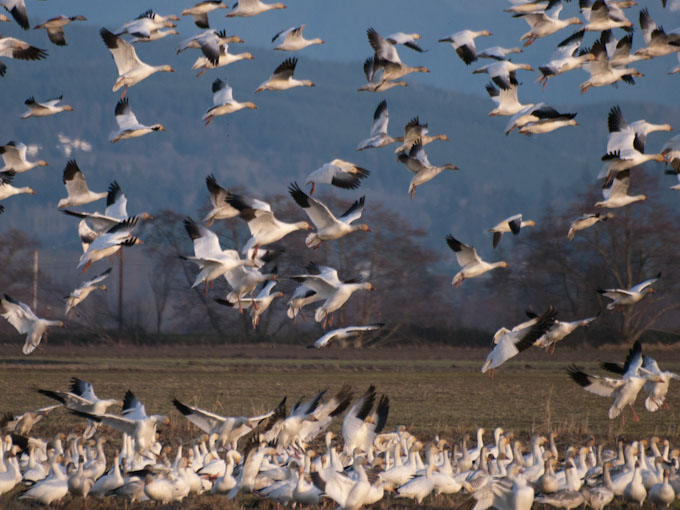
Two more hunters bolted from their camo ditches and fired repeatedly into the flock. They were shooting two minutes before legal shooting hours ended.

The flock raised up again and disappeared from the field so quickly that we went from the murmur 10,000 geese — to a barren field, all within two minutes.
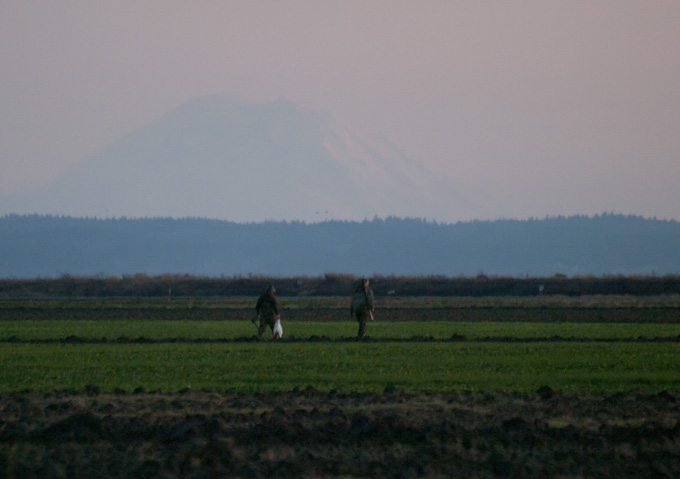
The hunters downed several live birds, killed them, and walked to their car, leaving these two geese, disabled in the field.
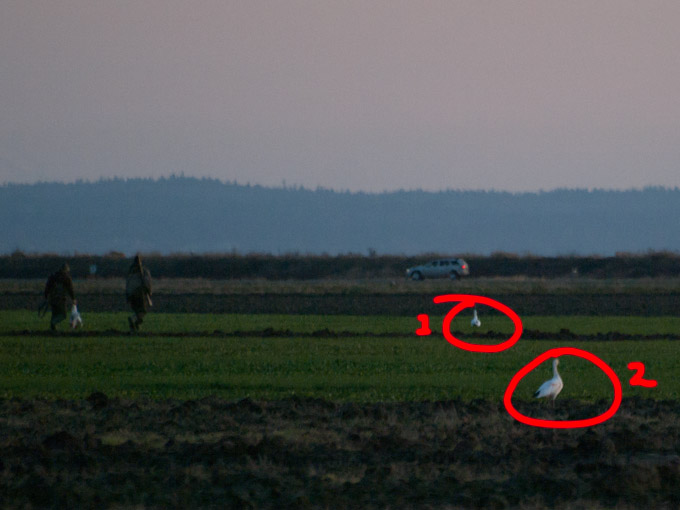
One hunter decided to turn back to the field. He grabbed the first injured goose and killed it. But he walked away from this obviously disabled goose left in the mud.
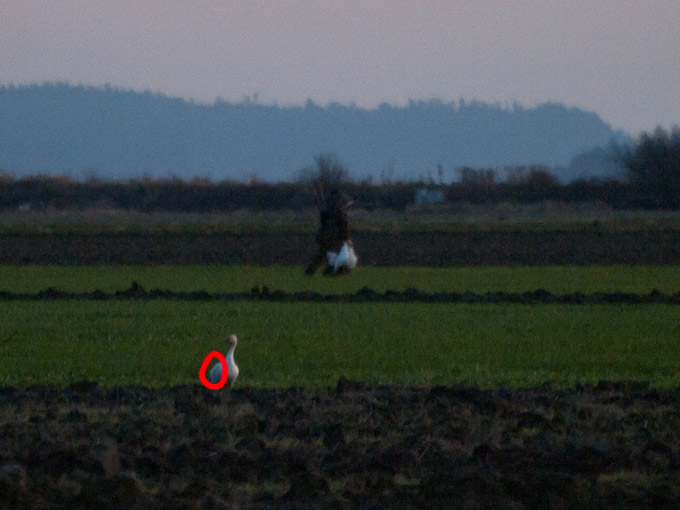
Through my lens, in the dark, I could see the goose had a bloodied right wing and was unable to fly.
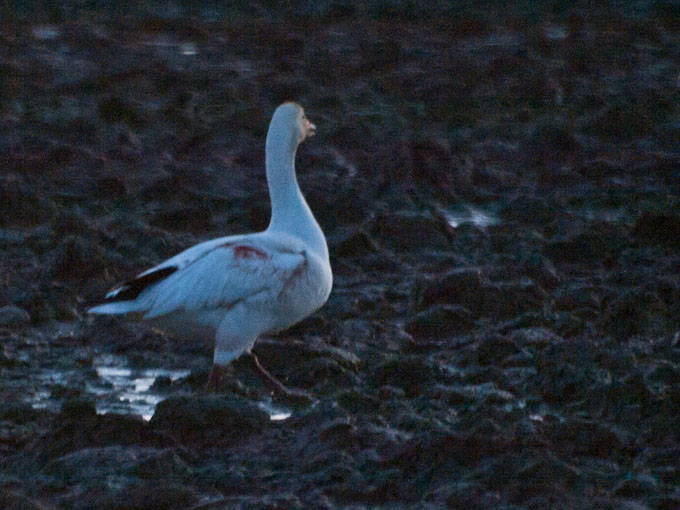
As as the light disappeared and hunters de-robed at their trucks, Hugh and I had to figure out quickly how to rescue the two geese left behind and then, where we would take them late in the evening. Our tiny apartment is, unfortunately, not an option.
The goose was moving toward the road, so we drove to a spot where we thought we might be able to intercept, if she was so weak we could actually grab her. We could hear her flock landing in a distant field, and she was calling out — either to them, or because she was alone or in distress.
Just as we were deliberating on how to best capture this goose if necessary, a hunter peeled onto the shoulder, leaped out of his car, and went chasing the goose to the other side of the road.
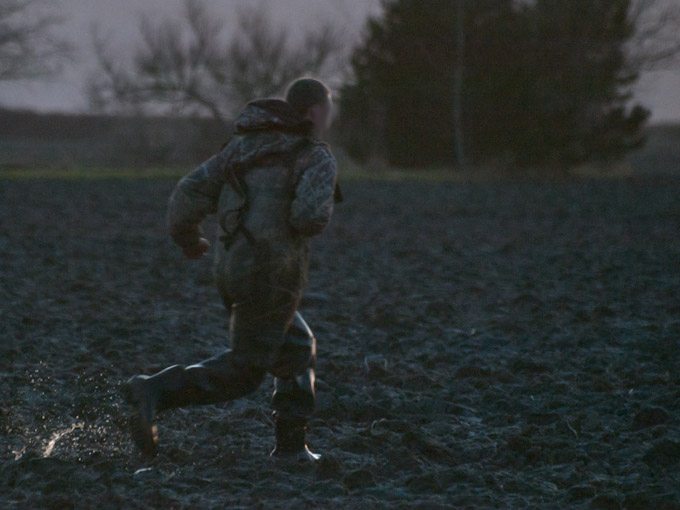
Honestly, I was relieved that this hunter at least showed a shred of responsibility in chasing down a bird he crippled, but it doesn’t make the situation any less horrifying. Some hunters don’t pursue fallen birds, even though hunters are legally bound to avoid “wanton waste” which is:
“… making a reasonable effort to retrieve all waterfowl that you kill or cripple and keep these birds in your actual custody while in the field. You must immediately kill any wounded birds that you retrieve and count those birds toward your daily bag limit.And by ethical hunting standards, if you shoot a bird, it is your responsibility to make sure you retrieve her. ~ U.S. Fish and Wildlife Service
The hunter reached the goose, and right at that moment, she collapsed into a heap of white feathers and blood, in a mud puddle at his feet.
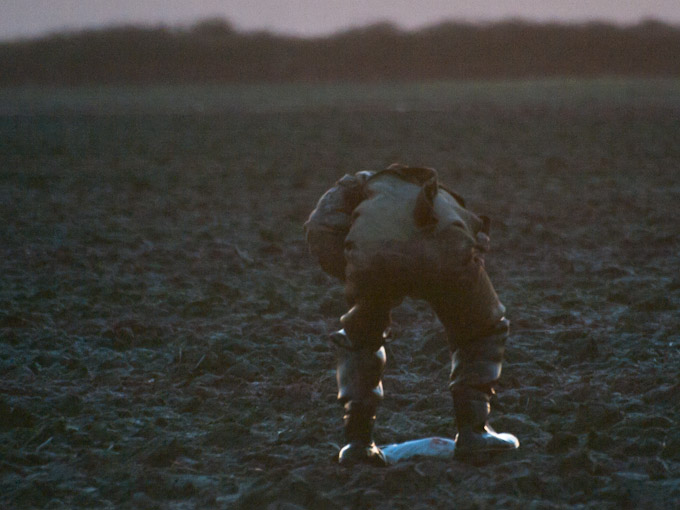
He picked her up by the neck, and although she was still alive, he waited until he got back behind his truck before he killed her.
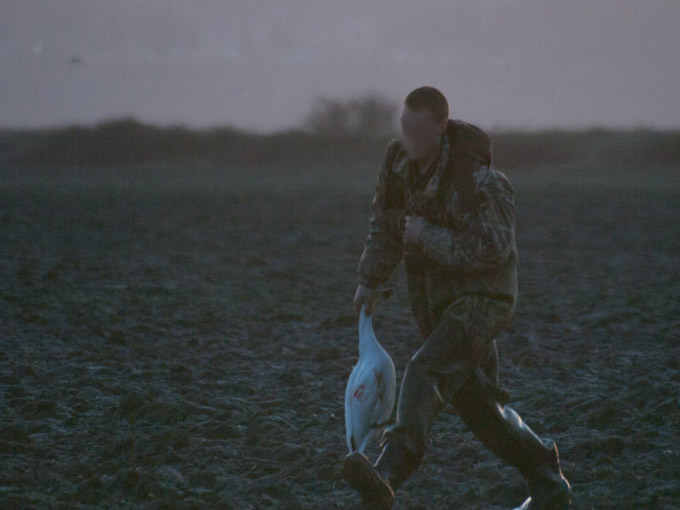
The hunter then noticed the injured juvenile goose I photographed earlier — with the blood on its backside. He took off into the field, trying to get this goose as well. But, as he got close, the goose could fly just far enough to evade capture … but not well enough to rejoin the flock.
The hunter gave up on the goose, but the goose remained alone in the field as darkness overcame us. I give this hunter credit for doing what he was supposed to do. But, of course, he was in full view and knew it. And, these last shots were fired after sunset, when visibility was low.
All of the birds they downed were maimed, not killed. And the possibility of leaving a bird in a bad condition is higher when you’re shooting in those conditions.
We couldn’t get the goose either. It’s the classic case of a bird flying just well enough to escape you, but not well enough to be safe. If we’d had a few other people to help — a better net — I’m not sure. Trying to wrangle a disabled bird and failing is heartbreaking … like the oiled gulls after Cosco Busan, who were clearly headed for hypothermia and death because of their oiled plumage, but were still well enough to leap to a light pole when rescuers tried to reach them.
I write about it every duck hunting season, about how many millions of ducks and geese are injured and never retrieved, left to suffer on their own. It’s a number that’s difficult to verify, for a lack of study. But the studies that have been done, like the one in South Dakota, indicate that injury numbers could be as high as 25 percent, which means 3.4 to 3.7 million ducks and geese are injured and not collected each year in the United States.
Keep in mind that Snow Geese are large, white birds on dark terraind. But, if you consider the complexity of marshes and wetlands, bad weather and reckless behavior, injured birds are easily lost. An injury might sail a bird into thick clusters of reeds that even dogs can’t reach … or graze a bird so lightly that it can fly for several miles before succumbing to its injury.
Some ducks like divers will submerge themselves after getting shot, and will even drown themselves as they cling to underwater reeds to escape. Hunters, even if they are candid about the numbers of birds they’ve crippled, don’t know how many birds they’ve injured. I hear enough hunters say, “I could swear I hit that bird but it kept flying,” to which my response is, well, you may well have hit him or her. You just didn’t see the inhumane outcome.
The waterfowl hunters I know will say that the injury rate is one of the risks they accept in the sport. We’re not asking the geese and ducks how “acceptable” that risk is to them. I feel the injury rate is too high to be acceptable.
Edited to add (2/4/12): I neglected to add to this piece that beyond the injured waterfowl, there is considerable cruelty toward live birds that are used in training hunting dogs. Birds like pigeons and domestic ducks, and game birds, are used to train hunting dogs to retrieve. In many cases, the birds are disabled in one form or another. I’ve seen video of dog-training pigeons with their wing feathers brutally pulled out by the trainer, so that the birds can’t fly to escape the retrieve. The whole endeavor of wing-shooting entails inhumane practices toward birds, both on and off the hunting fields. Some find it all acceptable. I personally don’t.

Thanks for writing this post so eloquently Ingrid, I find myself at a loss for words to use in my comment. I know that I feel intense sadness for the injured birds and thier suffering.
Thank you, Mia. I write these posts with reluctance because my experience in the wild, with my camera, tends to be the polar opposite of what I encounter in the hunting fields. But I figure if I’m there to document it, I might as well use the experience to shed just a bit of light on a situation that others may never see.
Ingrid, my experiences in the wild are the polar opposite of what you experienced too. I do some photography in an area where there is hunting but for the most part it is quite a distance from me although once a hunter did fire towards the road I was on and I could see the shotgun pellets hitting the water at less than a mere 50 feet from me.
I’m glad you wrote this sobering article for those people who may never experience this in the field.
Mia, the experience that really turned me happened when I was undergoing my early wildlife rehabilitation training. Hugh and I were in a residential area, observing a herd of elk playing in the snow — adults, young. The elk were bugling under the silence of snowfall. It was nothing short of spiritual and transcendent. We didn’t realize (owing to the residential environment) that a hunter was waiting just behind the trees.
The experience shattered me, what we witnessed in terms of the animal’s suffering — and also the herd’s reaction, something that hunter never saw, as the herd panicked and ran from the scene. I’d been around hunters most of my life in some form, but had never seen closeup, the archery death of a large mammal like an elk — and the ensuing behavior by the hunters, which was at best, callous, and at worst, cruel, from the perspective of someone who helps and cares for animals.
After this happened, I literally immersed myself in the hunting world to educate myself more, and to prove my impressions wrong. I talked to hunters, read everything I could get my hands on, and then tried to observe (usually while crying), what was going on, whenever I happened to be photographing or working in areas where hunters happened to be shooting and killing.
The truth is, what I was hoping to find was that what we’d witnessed with the elk was an anomaly — that I could rationalize it away as a fluke. But what I found, instead, was that what we saw was quite the norm. And that what we experienced was the literal tip of the iceberg and that things get much worse than that.
So, I’ve had a lot more hunting experiences than I ever write about. Most of the time, I can’t bring myself to take photos. It’s been too difficult to feel like a voyeur on the kill. But I’ve decided that from now on, if I encounter it, I will document it, particularly if I think something illegal is going on … even though my hands still shake as I’m taking the shots.
I still wish I’d saved the photos of the elk because those illustrations would have been much more powerful than what I could ever express verbally. But I was so traumatized, I deleted the photos from my camera right away. I didn’t want to be reminded and I also couldn’t stand that I’d been a witness to something I couldn’t stop. I talk to a lot of birders and photographers who are not bothered by these things in the way I am. I guess I’m just cut from a different cloth.
Ingrid,
Your experience with the Elk being brought down by an arrow in front of you would have traumatized me especially given the close proximity to a residential area.
I’m cut from a different bolt of cloth too.
My family and I are rennitg a house in Mason for Thanksgiving. We are looking for a day or two of hunting for our kids. We have a 16 yr old son and 13 yr old daughter. We are longtime hunters and both kids have harvested deer before. We will be in Mason until Sunday morning. Do you know of any hunts available? Doe only is ok. I just want kids to have the opportunity to hunt again. Bobby Soileau337 304 2864
This was a very informative post. I don’t hunt myself, but I’ve known several fellas who do. I always try to keep an open mind, and this post of yours was the best informed one I’ve seen. Thank you for a bit of education.
Thanks for stopping by, Katie. I know quite a few people who hunt, as well, and I dated a guy for a couple of years who was an avid deer and duck hunter. But, I always had a lot of discomfort with the sport. I was exposed to quite a bit of animal suffering as a young person, and I suppose that formed my views and my sensitivity. Of course, all of us learn to manage those feelings in ways that make life palatable. Unfortunately for me, I started to lose that defense mechanism, somewhere along the way. d:-)
Thank you Ingrid – First for the breathtaking photos! I never imagined how beautiful these Snow Geese could actually be while in flight! Makes me want to lift off the ground to join them! But then again…
Thanks too for your accounting of what might happen if I could! What a horrible thing to have to witness. The irony… Some shooting with cameras to capture something breathtaking. And others shooting with guns that actually do take breath away permanently. Capturing with a camera lasts forever… These poor birds destined for a meal will last but a few hours. I wish “hunters” (stalkers) could see the pleasure in the former, and the destructive, senselessness in the latter. I truly wish that.
The events you objectively document gives me an even clearer understanding of the views I hold. My empathy is evermore with the fallen birds…
Bea, thanks for stopping by … and for the information you provide at your blog. A few years ago, I attended a talk given by wildlife photographer George Lepp. He hunted when he was young, but gave it up when he couldn’t reconcile a quail kill he had to make. In his book he writes, “the bird was absolutely beautiful; it looked me in the eye with bright intelligence and I was obligated to end its innocent life with my own shaking hands. I became a non-hunter that day, and more than fifty years later, I am still haunted by that valley quail.”
The reason I mention this is because later in the same chapter, he alludes to precisely what you say above — about shooting to capture an image, versus shooting to kill. He says:
That’s from Wildlife Photography: Stories From the Field
Ingrid, this is so heart wrenching I can’t even say. I don’t see how anyone can call this a sport. I understand back in the days of yore when folks had to hunt for food. But now? For sport? It goes against every part of my being.
Thank you for documenting this with such a well written piece. I hope it opens some people’s eyes to what is really going on during these hunts. I thank God that at the wildlife refuges I visit, the hunters are far removed form the general population. We do see them on the auto route sometimes, driving as fast s they can to force the birds into the air. It’s obviously illegal and if they are caught a large fine I’m sure. I always cut them off and drive real slow 😉 All in all, I try to avoid hunters whenever possible.
Larry,
Don’t thank God for the Wildlife Refuges that you visit… Thank the hunters! You see, Lawrence, the hunters aren’t as far removed from them as you’d like to think. Those hunters provide a lot more money to aquire and maintain those lands than any photographer ever has or will. Excise taxes on firearms and ammunition have provided over $2.5 billion to the states for wildlife and habitat management. While none of the excise taxes have been used to aquire the Federal land, the sale of Migratory Bird Hunting and Conservation Stamps (Duck Stamps) have brought in about $477 million since 1934. Approximately 10 percent of the Duck Stamp revenues come from non-hunters (stamp collectors, art dealers, hobbyists). Another $197 million has been added to the Migratory Bird Conservation Fund as an “advance loan” from the Treasury. Finally, about $153 million has been added to the MBCF from import duties on firearms and ammunition and from refuge entrance fees. Not to mention the MILLIONS donated by Ducks Unlimited and the Washington Waterfowl Association. I personally bought 3 Federal stamps and 3 state stamps last year… only needed one. In addition to the $386 dollars in license fees, roughly $400 in ammunition, $600 in firearms tax and $2,300 in charitable donations to DU… What did you do to ensure that the birdies will be here? Or were you under the impression that they just show up to the same place every year for no reason? Maybe next year when you want to take pictures of the Snow Geese, you’d be happier if there were a nice strip mall in that field? So how about a little give and take, Larry? You enjoy it… We pay for it.
PCR, I don’t speak for Larry, but I will speak to your points with my own perspective.
First, I’d like to know where you get your “approximately 10 percent of Duck Stamp revenues come from non-hunters” figure. I did not receive a reply from the Duck Stamp office when I asked about tracking non-hunting revenues through purchases. You do realize that there is no designated checkbox for “non hunter” if you purchase stamps online and so forth, so I’m not sure how that 10 percent figure is even acquired through that accounting. If you have a reliable statistic and reference, I would actually appreciate having this, since tracking non-hunting revenues is a significant complaint non-hunters have when purchasing Duck Stamps. The revenue tends to be grouped together as hunting revenue, and hunters are given priority usage and a stronger voice on refuges as a result.
Second, I understand that hunting organizations promote habitat restoration for the purpose of adding and preserving land for hunting and hunters. At the same time, you’re not taking into account the countless organizations, many local and hyper-local, that preserve lands in trust, restore wetlands habitat and so forth, without the sometimes skewed priorities of favoring just game birds and animals expressly for the sport of hunters.
Third, if you’re asking Larry personally what he does, you need only look to his website for how much of his life he devotes to strong advocacy for habitat and wildlife issues. You’re criticizing the wrong person with your “birdies” pejorative.
Other non-hunters, like myself and my husband work in wildlife hospitals, roll up our sleeves in wetlands and habitat restoration projects, and generally contribute whatever time and resources we have to those ends. And we do so, again, for the inherent value of the habitat and the wildlife that requires the habitat …. not for exploiting the wildlife through sport.
Because you posted under an alias, there’s no way to establish what your actual contribution is. That’s not important from my perspective because anonymity is obviously a privilege of Internet posting. But, given this particularly weak stance, I would be more circumspect about writing those types of sardonic and patronizing comments about others who fully reveal their proclivities and agendas.
Fourth, the comment below comes from the U.S. Fish and Wildlife Service. The figures you cite obviously come from this report, but the report also says this — an important element you left out of your statistics:
“Collectively, these MBCF funds have purchased about 2.7 million acres (about 3 percent of Refuge System lands).”
Considering that the funding for the various conservation funds mentioned comes from public monies in addition to Duck Stamp revenue, the picture is not as clearly hunter-dominant as you suggest.
Lastly, I’m assuming that since funding provides, for you, the primary rationale for hunting’s disproportionate priority on Refuge lands, particularly during migratory bird season, you won’t have any complaints when the 71+ million of us wildlife watchers (compared to 13+ million hunters) behave with the same sense of entitlement, once our contributions are finally counted separately, and as accurately as hunting revenues are.
Thanks Ingrid! I could not have stated it better. I guess many hunters like to regurgitate the “we pay for the wildlife refuges” rhetoric thinking (and rightfully so) that most folks don’t know the real facts. PCR has made the mistake of commenting on a blog where there are people knowledgeable about the subject and additionally have all the facts and figures to support our contention that once the revenue for “non-consumptive” refuge users is accurately measured, we will have more to say about how our wildlife refuges are managed the the dwindling number of hunters.
Ahhhh yes, the conspiracy to make sure that the delicate Birders don’t get their credit due! I forgot about that… I thought that was a secret… I guess the cat’s out of the bag!
Obviously I cited FWS for the figures on duck stamp revenue. I guess you don’t find that to be accurate? I can understand that. What I don’t understand is why you find those numbers to be wildly inaccurate and “unreliable”, but you’re willing to use their figures to support your own argument. That hardly seems fair, Ingrid. I’m also not clear on what you consider to be “priority usage and a stronger voice”. I am restricted to using the land that we are discussing (for hunting purposes of course) for 107 days of the year, for a maximum of 10 hours a day at best. I’m not a mathmetician but that leaves you 258 days to use the same land for whatever purpose you like. Those 258 days would be in addition to my 107…
Obviously your understanding of “hunting organizations” role in habitat restoration soley for “hunters and hunting” isn’t as clear as you believe it to be. It’s clear to me that you’ve managed to gain some perspective from both sides… maybe not enough. I mentioned DU & WWA in my original post. I’m sure you’re aware that more than a third of the land that DU aquires, is closed to hunting indefinitely. I’m not sure if you’re familiar with WWA? If you are, you know that a large portion of their donated funds are spent building blinds that are primarily used as “viewing” blinds… AND wood duck nesting projects. I’m also sure that you realize that wood duck hunting is all but non-existent in WA, so surely you won’t attempt to argue that we nest them so we can hunt them.
And yes, I was asking Larry what he does personally. I can and will argue that I devote just as much of my life to habitat and wildlife issues. However, I don’t bash Larry for what he chooses to do with the wildlife. While I don’t understand why a birder would put themselves in, on or around a hunting area during legal hunting times; I certainly don’t interfere with what they are doing when I come across them, simply because I don’t understand.
As far as my “alias” is concerned, those are simply my initials. My name is Patrick, I grew up in Skagit county and currently live in Snoqualmie. It seems as though you’re suggesting that I used an alias so you couldn’t disprove the contributions that I’ve claimed to have made. However, I’m not sure how providing my name would help you. You suggested that I see Larry’s website… A quick Google search of Larry Jordan tells me that he is a DMC for Apple, a filmmaker, a collage artist, the brother of hall of fame basketball player Michael Jordan, a blogger and even a bishop! My hat’s off to ya Larry, you’re a busy guy! I guess since he used his unique name, that constitutes a revelation of his proclivities.
Lastly, I guess I’ll again question your “disproportionate priority” argument, since in the same breath you mention my season… And again I’ll point out that you don’t have one. And while you’re considering my figures on Duck Stamp purchases to be skewed, please realize that the FWS is going to consider everyone on the property a “wildlife watcher”… Even me when I’m there in the off season and the guy that doesn’t own a gun or a pair of binoculars. So let’s not be ridiculous. You’re clearly not an idiot, so lets not pretend that you truly believe that the difference between watchers and hunters is almost 60 million. Just like you’re not required to check a “non-hunter” box when you purchase your Duck Stamp… Nobody checks a “wildlife viewer” box to enter a wildlife refuge. We’re all wildlife watchers! Even the evil hunter.
When it comes to a “sense of entitlement”, I’m not sure what you call a birder standing 50 yards from a hunter in a hunting situation… But, it happens. And unless the aforementioned birder has a death wish, I’m going to consider it to be a sense of entitlement.
Patrick, I have some responses to your various comments, but will be away from the blog for a few days. If anyone else wants to chime in, obviously feel free. I appreciate your interest in the discussion and am open to entertaining your perspectives, although I disagree with many of your assertions. It would be easier to consider your points more seriously, however, if they weren’t laced with sardonic personal disparagement. I realize it’s an easy default position to make character generalizations when presented with counterpoints to your arguments. And, you’re obviously free to hold on to the perceptions that help rationalize your worldview and your view of non-hunters. But, they don’t give you added credibility in this discussion. I mean, if you can’t even link out to Larry’s site with some modicum of thoughtfulness, it weakens your commentary from a rhetorical, philosophical and ethical position.
Ingrid,
I’d actually like to hear you responses to my comments.
I am quite interested in this discussion, however, I’m here with almost no hope that you will entertain my perspectives. I’m sorry that you find me to be cynical or sarcastic. I’m even more sorry that you think it’s doled out as a defense mechanism, in the event that I can’t muster a factual retort.
You see, I find Larry’s comment that I am not aware of the “real facts” and he is, to be equally disparaging and I responded accordingly.
Furthermore, your belief that I “hold on to perceptions that help me rationalize my world view”, leads me to believe that you also feel as though your world view is somehow more pure and enlightened than mine. I’m also not sure that you truly understand my perception of non-hunters. Are you assuming that my world is so small that I only surround myself with hunters? My wife and daughters are non-hunters… Care to take a guess at what my view of them is?
I’ve stated what I believe to be facts, none of which you can discount with anything other than what you BELIEVE to be fact. I don’t believe there are any indisputable facts on either side of this argument, other than I hunt and you don’t.
What is it that makes your ideas “fact” and mine rhetoric? The groups and organizations from which your facts stem? Or would you like me to believe that you are the source of all of these facts based on your years of research?
I could cite multiple sources to discount anything you believe to be fact and I’m beyond confident that you could do the same. So who’s right? You because you don’t like what I do? The fact is, if either side had stone cold facts, we wouldn’t be having this discussion.
I have a very clear understanding of why you feel the way you do. I understand why what you’ve witnessed bothers you. Believe it or not, I also understand the thought process behind sharing your feelings about this particular experience. I rarely share the same feelings. Are you better than me? I doubt it.
What I do have a problem with is the undertone that all hunters are barberic maniacs that don’t deserve the respect of the general public.
I do as much (if not more) for the outdoors as anyone with the gumption to post here. Is all of it related to hunting? No. In fact, most of it isn’t. The notion that any group derserves to use the outdoors more than another, based on nothing more than their personal beliefs, is one that bothers me. There are far more users of the outdoors than there are champions for it. However, I don’t feel the need to bark at them because they choose not to involve themselves in it as deeply as Larry or myself.
I’ve come to realize that most of our objectives are similar. While we will always always disagree on the subject of hunting, I will thank any conservasionist for their efforts.
If you decide to make your way to the Skagit Headquarters Unit at 4am on Oct. 15th and occupy a duck hunting blind, before I get there, for no reason other than to take pictures, I won’t attact you with harsh words or disdain. In fact, I would just smile and comment on the weather.
If you think that my goal is to change your mind about hunting, you’re wrong. If you choose to continue to believe that humans must be “at least a few different subspecies” because their beliefs are contrary to everything you feel, I feel sorry for you.
Patrick, I don’t know how most of the refuges are operated in Washington but I’m sure when Ingrid mentioned hunters are given “priority usage” she was referring to the fact that some refuges are closed to the public during hunting season. This would obviously contradict your statement: “I’m not a mathmetician but that leaves you 258 days to use the same land for whatever purpose you like. Those 258 days would be in addition to my 107…” This means that you would have 107 days of use in excess of every non-hunting citizen.
When I spoke of “the real facts” I believe Ingrid and myself were both referring to the “National Survey of Fishing, Hunting, and Wildlife-Associated Recreation” which is a survey coordinated by the USFWS. It is conducted about every five years. If you are interested in its contents you can Google it.
I don’t really want to get into most of the ramblings that you have expressed here but I did notice that you made no comment on the actual post that Ingrid wrote concerning hunters leaving wounded birds dying in the field. Are you OK with that? Does that bother you?
One important question that I would like an answer to is, why do you enjoy killing other animals? Seriously, I am curious as to what makes people want to kill other animals.
If at all possible, I would appreciate a non-condescending answer. You see, my main problem with your narrative is your tone, not your content.
Patrick,
Because of the length of your various commentaries, I thought it would be easiest to address your main points as bullets.
— You wrote: “What I don’t understand is why you find those numbers to be wildly inaccurate and “unreliable”, but you’re willing to use their figures to support your own argument. That hardly seems fair, Ingrid.”
My response: It is a superficial figure that does not take into account that there is no accurate accounting of these fees. That was the point. If I purchase a Migratory Bird Stamp online at the Post Office, for instance, there is no check box indicating why I’m purchasing the stamp. This revenue is not tracked, so, a 10 percent estimate is just that: an estimate based on the numbers that are tracked (at some individual refuges, for example). The Duck Stamp office did not respond to my request for clarification on this.
— You wrote: I am restricted to using the land that we are discussing (for hunting purposes of course) for 107 days of the year, for a maximum of 10 hours a day at best. I’m not a mathmetician but that leaves you 258 days to use the same land for whatever purpose you like. Those 258 days would be in addition to my 107…
My response: Well, for one, you are not “restricted” in access. You can use the lands as a hunter or as a wildlife watcher, as you claim you do. As Larry already responded, some refuges close off significant portions during waterfowl hunting season — to all but hunters. Of course, there are safety issues involved in mixing hunting with non-hunting refuge activity. But it simply cannot be argued that non-hunters have equal access. In fact, I can’t think of one refuge where, even after the season, the large numbers hunting blinds are then opened to photographers or birders. It generally doesn’t happen. The lands that are hunted, sometimes only accessible by boat, are closed after the season, not opened to non-hunters. I’m actually not arguing that they should be. I would argue more strongly that those areas be limited to all humans for the sake of the migratory wildlife, to have some semblance of sanctuary on our so-called “refuges.” It would be more prudent to allocate some of hunting season to birders and photographers in those same areas.
Add to that the fact that waterfowl hunting on refuges in Washington and California, at least, begins in mid-October and runs through the end of January. In early October, the winter migrants have barely begun to arrive. And after the end of January, some are already close to migrating back to their breeding grounds. In California, there are restricted usage days for hunting on many refuges (Mon, Wed, Sat). In Washington, as you know, many refuges have week-and-weekend-long hunting access. That leaves very little time for anyone interested in non-hunting wildlife activities to view migrating wildlife without the assault of hunting pressure.
Beyond that obvious division of priorities, there’s the issue I’ve already addressed in part, of non-extractive users sharing land with activities that are inherently violent and disruptive to the wildlife. Even in those refuges where I can go and be somewhat close to hunting activity, I would not call photography and hunting necessarily compatible when what I’m photographing is the constant barrage of killing that’s taking place within ear and eyeshot, not to mention how this affects the behavior of wildlife in unnatural ways. Even with the more limited hunting days in California, if you go to heavily hunted refuges on the “off” days, not only do you have the aforementioned limited access because of trail closures and so forth, you’re also dealing with wildlife that’s skittish in response to the trauma of hunting pressure.
I’ve had hunters argue with me that waterfowl is very little affected by hunting pressure — that once outside the hunting zones, these birds return to their normal preening and feeding behavior. If you are, as you claim, a wildlife watcher outside of your hunting activities, you will know this to be abjectly untrue. I’ve spent ample time in hunted and non-hunted areas, and the behavior of birds in or near hunting zones can be construed, at times, as abject panic. The slightest footfall will send all of them flying.
In fact, since you hunt, you know that late-season duck hunting differs in methodology from early-season, precisely because hunting has such a dramatic and often deleterious effect on the behavior of birds. This snippet below comes from Ducks Unlimited, actually:
“With the exception of the weather, nothing has a bigger impact on waterfowl behavior these days than hunting pressure. While duck harvests have declined in recent years from the record highs of the late 1990s, waterfowlers continue to spend more days in the field and are bagging more birds than at most times in modern history. The widespread use of ATVs, mud motors, mechanized decoys, and other high-tech gear has also made duck hunters more mobile and effective than in the past, exerting ever greater pressure on the birds. Waterfowl have reacted to the onslaught by becoming more elusive …”
— You wrote: I mentioned DU & WWA in my original post. I’m sure you’re aware that more than a third of the land that DU aquires, is closed to hunting indefinitely.
My response: Many if not most of DU-owned lands are open to hunting. You’re undoubtedly referring to some of the land-swap/easement deals DU has on land that’s not outrightly owned by DU. That’s a bit different.
— You wrote: I’m not sure if you’re familiar with WWA? If you are, you know that a large portion of their donated funds are spent building blinds that are primarily used as “viewing” blinds
My response: I am, of course, familiar with WWA. Can you link me to the information about the WWA blinds that are used primarily for viewing? Where are they located, and what is the percentage of blinds compared to hunting blinds? I obviously have read WWA materials in order to familiarize myself with hunting and regulations in Washington, before I ever went out into the field. Both DU and WWA are fervently pro-hunting, unabashedly, with WWA having its origins with hunters and hunting advocacy, often in direct conflict with non-hunting interests. So, although you obviously have a resource for the information here, I’ve not been able to find it.
— You wrote: I guess I’ll again question your “disproportionate priority” argument, since in the same breath you mention my season… And again I’ll point out that you don’t have one.
My response: It’s only in recent times that state wildlife departments have even *acknowledged* non-game species with any sense of the same relevance or importance as they have game animals. It was only in the 1990s that refuges even started seeing their management priorities as embracing of entire ecosystems as opposed to duck-management systems. There are many species that are woefully under-studied in response to these skewed priorities. And then, when their focus changes to embrace non-game endeavors, the efforts are frequently under-funded. You obviously realize that significant portions of funds collected through hunting-specific programs and excise taxes have stipulations attached in terms of where those funds can go, “hunter education” and promotion of hunting interests being among the priorities of allocated funds. The NRA has been busy drafting (and helping to pass) further regulation to ensure that these priorities remain at the forefront of wildlife “management” on refuges and public lands.
Even when wildlife departments evolve to embrace non-game endeavors, the resources aren’t always there to pursue these efforts. One could argue that the lack of funding is the responsibility of us non-extractive users who clearly do outnumber hunters. But, take, as one example, the contentious situation surrounding the CARA law in the early 2000s. Many hunters and hunting groups fought against this large and viable funding stream that would have provided alternative revenue to those very needed resources. I find that, in large part, hunters like to cite their contribution in financial terms, but it’s quite threatening to hunting interests as a whole when they’re presented with a change in the system that could also change the balance of voices when it comes to public-land decisions.
Lastly, on this point, I have more than one anecdotal example to illustrate the above issue, but here’s one from last year. My husband and I encountered a situation where, due to the negligence of a Washington bait company, gulls (federally protected species) were being entangled, asphyxiated and significantly harmed by nets. When I contacted WDFW about the situation, they were kind and accommodating. But, my request to investigate the situation came right at the onset of hunting season. And, as the officer reminded me (as if I needed reminding), most of their staff would be in the field for the next several months, monitoring hunting stations and hunting violations. The gulls, Federally-protected species of mixed birds in this particular instance, were relegated to very low priority as a result. This is a microcosm of yet another resource-allocation issue that results from, again, this lopsided structure in our wildlife systems.
— You wrote: So let’s not be ridiculous. You’re clearly not an idiot, so lets not pretend that you truly believe that the difference between watchers and hunters is almost 60 million.
My response: Why don’t you calculate the math for me then since my contention appears to be ridiculous. According to the latest (2012) USFWS report, there are 71.8 million wildlife watchers. There are 13.7 million hunters. I believe 16+ was the age group surveyed. Even if every one of those 13.7 million hunters is also a wildlife watcher, where does that leave the figure in terms of discrepancy?
— You wrote: When it comes to a “sense of entitlement”, I’m not sure what you call a birder standing 50 yards from a hunter in a hunting situation… But, it happens. And unless the aforementioned birder has a death wish, I’m going to consider it to be a sense of entitlement.
My response: As I noted above, there is a questionable and often impossible assertion that hunting is comparable with bird watching, photography, or wildlife watching in the same areas. As I noted above, first, huge portions of refuges are closed to all but hunters which creates a primary imbalance. Second, birders and wildlife watchers, for lack of a better term, are non-consumptive or non-extractive users. We do not remove “resources” from the system, although I’m loathe to use that word because I believe referring to wild animals as resources is part of what leads us to some of these callous management decisions (wolf “management,” as one example).
The fact is that you cannot equate the two activities and claim that your tolerance of birding should somehow equate to our wholesale embrace of hunting as sport. One activity (hunting) is inherently violent, damaging to the animals in question, disruptive to the environment with respect to animal well-being and behavior and also with respect to sound and visceral disruption. As a photographer, especially one with some ethical stance toward field behavior, the impact on the animals and the others around me is minimal by comparison. And, the land is easily shared among wildlife watchers who, again, leave the refuges, the plants, and the animals intact after leaving.
So, when you write: “If you decide to make your way to the Skagit Headquarters Unit at 4am on Oct. 15th and occupy a duck hunting blind, before I get there, for no reason other than to take pictures, I won’t attack you with harsh words or disdain.” Again, you make my point. Of course you wouldn’t attack me, but not because a hunter’s prerogative is necessarily more magnanimous. It’s because, aside from simply using your blind, what ostensible interference would I incur, aside from taking up physical space in that blind, which, would be pointless, again, because of what I would encounter outside the blind in the presence of hunting? I would, of course, be interfering with your ability to hunt from that blind. But, my activity as photographer or wildlife watcher would in no way interfere with the hunting going on around me, much as my photographing the sad goose hunt above didn’t stop the hunters one iota. Firing a rifle or a shotgun, however, where I’m photographing, would have a significantly deleterious effect, as it has many times. I’ll mention again that I’m not arguing for more photographer access. I’m arguing for less intrusive access by humans in ever-shrinking habitat for wildlife.
The above is not even taking into account the extraordinary amounts of litter left behind. Care to know how many shotgun shells we who share the land come upon? In fact, I noticed that WWA finally implemented some drop-off canisters precisely because people were picking up literal bags of discarded shotgun shells on the shores. I’ve encountered this in many wetland and shoreline situations.
And that’s not even taking into account the extraordinary numbers of animals injured and not retrieved each year by hunters which could validly be argued as an abuse of public trust. In waterfowl hunting, as I mentioned, there are pitiful few studies done on this, but one South Dakota study found that as many as one bird is injured (a cripple, as you guys like to say) for every three four shot and retrieved. As an animal rescuer, I’ve worked with people who try and care for animals and if you think it’s a non-issue, I challenge you to to take a look at one of these birds, shot by yourself or a fellow hunter who’s been languishing with internal septic infection and left for dead. When you consider that millions are left this way by the sport of hunting, your impact transcends even the most obvious ones I’ve cited above.
— Lastly, you wrote: Ahhhh yes, the conspiracy to make sure that the delicate Birders don’t get their credit due! I forgot about that… I thought that was a secret… I guess the cat’s out of the bag!
My response: Putting aside the fact that this is the very tone Larry alluded to, with comments like this, you simply can’t argue that your impressions of non-consumptive users of wild lands — of non-hunting photographers and birders — is anything but sneering. I’m sure you don’t view your non-hunting wife and daughter in this way. But, I also suspect that your non-hunting family members embrace your hunting, which puts them in a different category from the birders you view here as your “delicate” counterparts in the field.
For the record, my husband and I are also trained wildlife rehabilitators, so although you’re free to carry on with your misguided impressions of what constitutes a non-hunting wildlife advocate, delicate or other, I would suggest that despite my smaller stature, “delicate” is not a quality one fosters by being in the trenches of animal rescue, rehabilitation and also confrontation with the likes of hunters. I would almost guarantee you that when you’re out in the field, armed and in camo, you’ve rarely if ever felt threatened by a person with binoculars, a camera or a spotting scope. Put yourself out there, however, as a woman alone with a camera, or a woman in the context of a wildlife rescue, and I’ll show you a thing or two about why your disparaging attitude toward the rest of us goes beyond mere semantics. It leads to an overall tone of disrespect and sometimes threatening postures that, I’m sorry, you simply do not encounter in the context of other wildlife watchers.
Larry, I’ve reported hunters illegally driving ducks with boats, but I’ve never seen them flushing birds with cars. I guess it shouldn’t surprise me, though. There is, unfortunately, a lot of bad behavior out there — heavily-armed bad behavior. Good on you for slowing them to a crawl. I have sometimes joked that we humans must be at least a few different subspecies, because the drives and impulses that some people claim are innate to humanity, are — for me (as you say) — contrary to everything I feel.
Oh. Bless your brave heart for witnessing for these poor birds and doing your best to reduce the suffering. I can’t imagine the pain that you were in and carried away with you to hold forever from the experience. How anyone can take the life of another for sport or fun, I will never ever understand. And thank you for introducing me to the quote by George Lepp. It is a powerful point for the advantages of camera shooting over gun killing.
Elizabeth, I don’t understand it either, much as I’ve tried. The funny part is, I know a lot about the sport, I know a lot of hunters, I’ve engaged the topic for years now. It just gets more difficult for me, the more I learn. I sometimes wish I could be complacent. Life would be easier. I find I keep going back to days like this in my head. I never lose the imagery and now I have a head and a lifetime full of such imagery. A lot of good that does me, huh? d:-)
[…] in the wind. Instead, you'll be plucking some geese and getting ready for some quality meals.It's hard to believe, but early goose season is almost here. Depending on where you're hunting (Mass…" width="250" height="166" />It's hard to believe, but early goose season is almost here. Depending […]
[…] This year, I’ll just point to two additional posts I’ve written on the subject of hunting since I first posted Fly Away Home (and Safe): 1) Non-Hunters and National Wildlife Refuges, and 2) The “Cripples” — or Why I Hate Wingshooting. […]
I have been waterfowl hunting for 34 years now and agree that leaving wounded geese is NOT the right thing to do – for sure. Responsible shooting is always the best approach. Unfortunately, sometimes when aiming for a single goose, the spread of the shot will be wider than anticipated and accidentally knock down additional geese. The hunter is trying to be responsible but accidents do happen. If the additional goose/geese cause the hunter to exceed their daily limit, then chasing down and harvesting that goose could turn into a hefty fine if caught by the authorities. So it turns into a double-edged sword.
Please note: I am not here to excite anyone. I am only raising a legitimate question.
My question is… If my morals prevail and I do the right thing, why then should I get punished?
Dear Dave, thanks so much for stopping by and for taking the time to leave a comment … especially one that challenges the prevailing sentiment of this thread. I know that’s not a particularly easy challenge to take on (I’ve been there). I’ve expressed my personal feelings about waterfowl hunting in this essay and elsewhere, so it would be redundant for me to reiterate just why I have such a difficult time with the practice of wing shooting.
I will just add that while I don’t consider these ideas punitive, I understand why you would view them that way. After 34 years, waterfowl hunting is undoubtedly a significant part of your life and of your personal experience. Like you, however, I am raising legitimate questions and issues. In this case, my concerns involve a practice that, as you know, covers a broad spectrum of ethics, skill and intent in the field.
Your comment shows obvious concern for birds and for ethics. I suspect you’ve seen it all. Where I assume you and I diverge — because it’s where I differ with most hunters — is that you may find the ancillary harm an acceptable facet of sport, whereas I simply cannot find a way to rationalize what I’ve seen, particularly since hunting is often engaged for the sense of personal satisfaction. My feeling is that any sport with that degree harm as an outcome, ought to open to scrutiny and change … especially as our cultural, moral and scientific paradigm about other animals moves toward greater understanding and compassion. Of course, that doesn’t mean you and I will ever agree, but it certainly begs for a discussion of what we ought to accept as we evolve toward (I hope) a more enlightened perspective on our world and our interconnectedness with other species.
I had absolutely NO IDEA the absolute horror that duck hunters unleash on wildlife. I am avid birdwatcher and animal lover. I understand deer hunting, but this is sickening!! We just moved to the shores of the Chesapeake Bay. I seriously thought someone was doing construction (thought it was hammering, but it was CONSTANT GUNSHOTS!!).
I say we all get our hunting licenses and go Elmer Fudd on their party (“Oh, I’m sorry. Did I not time that gunshot right? Sorry!).
Here is another sad link (but it’s better than being ignorant of this disgraceful “sport.”)
https://carlsafina.org/2012/01/18/enough-duck-shooting-by-carl-safina/
Dear Laurie, thank you for the comment … and I’m sorry you’ve encountered the same distress many of us do when we find ourselves in these situations. I’ve been immersed with hunting issues for a long time now, and I’ve yet to meet a waterfowl hunter who truly understood why these actions were so upsetting to people like me who care about these animals. Most often, my perspective as a former rehabilitator has been demeaned as unrealistic and soft. If that’s the case, I intend to remain “soft” for the rest of my days, because I still believe — however unrealistically — that compassion is a better guiding principle than “resource extraction,” when it comes to our treatment of other living beings. Thank you also for the link to Carl’s piece. Other people should check it out. I relate very much to what he wrote.
Laurie, here’s another piece I used to re-post every year at the onset of hunting season. The link is buried in my text above, and I mention it just because it contains some figures about injury rates and some practical and troubling considerations about waterfowl hunting in particular: https://www.thewildbeat.com/2013/10/20/fly-away-home-and-safe-2013/
Ingrid
How do you feel about hunting and fishing in rural areas such as remote Alaska where families literally have to choose betwean hunting/fishing/harvesting shellfish and starving to death? I ask this question in all sincerity and without jest or sarcasm. I am truly curious. Additionally, how do you feel about meat sold in grocery stores? Finally , do you value plant life as highly as animal life ? We all have to eat so it appears strange to state that killing is wrong when survival is the function of killing; whether it be a goose, elk , or plants .
As a responsible hunter and conservation minded individual I suppose I feel we are all beholden with the responsibility to care for nature in a way that uses the resources God give us wisely and in their intended purpose.
Stephen, thanks for taking the time to comment. I suspect you and I agree on various conservation issues, based on your personal stance. In response to your questions …
On subsistence hunting, I don’t live in Alaska, although my husband has. He did encounter true subsistence hunters who traded at the depot once or twice a year but otherwise lived in the wild without other amenities. That lifestyle is a far cry from the subject of this post, and a separate issue from the wing-shooting issues I discuss here. With very few exceptions, the hunting I encounter on shared lands on the west coast has much more to do with sport and enjoyment than it does base-level survival. Even when the meat is used, we are not talking about a level of starvation that would justify the inordinate amount of injury (as high as 50 percent injured and not retrieved) and brutality that this type of shooting often involves. This scenario here has no easy justification for someone who cares deeply about wildlife, in terms of the violence perpetrated against these birds.
Second, on meat. I personally don’t eat it for the very reasons I have issues with hunting. I see a more peaceful ideal in the Buddhist idea of “ahimsa” or non-violence. And I do not believe we can strive for a non-violent culture or world in as much as we condone the rampant violence we perpetrate against other sentient species and against nature.
As far as plants, it’s a red herring of an argument, not because we don’t value the importance of the plant kingdom. But plants do not share the same nervous systems and sentient responses that we obviously share with other animals, and for that reason it’s sketchy to make an equivalency argument in terms of suffering incurred. You simply cannot equate the suffering of a gut-shot deer with the picking of an apple. That doesn’t diminish the fact that plants are living entities and deserving of our respect and care on this planet. But the “what about plants” argument is also a recent meme perpetrated in hunting circles, to try and undermine plant-based philosophies and rationalize the status quo in terms of how we treat other animals.
That being said, if you want to go with that argument, then anyone who abstains from meat is responsible for far fewer plant deaths than those who eat meat. Directly consuming plants is a far more responsible and far less resource-intensive way to share this planet with all others.
Lastly, as far as resources “God” gave us, I don’t share your belief in a god who would condone the type of cruelty we inflict on other species for the sake of our preferences and palates. That’s not my “god.” I do, however, understand that many believe that their religion and God give them entitlement to use animals in any way they see fit.
Ingrid
Thank you for taking the time to respond it helps me understand your perspective on the subject of hunting. I certainly agree that if one kills an animal it should be eaten and done in a manner that reflects responsible harvest.
Have a great day.
Stephen
I’m late in viewing your post. Nonetheless, thanks for “The Cripples”…living on Fir Island for the better part of two decades I have a new and very low estimation of goose + duck hunters.
In brief, sportsmen? Hell no, these are not sportsmen. Stupid dudes? Absolutely…no doubt about it. I have attended their Fish & Wildlife meetings/rabbel which are evidence enough that goose + duck hunters are essentially disturbed and/or stupid dudes requiring much day care in the form of enforcement.
Been one heck of a realization. One can witness your experience regularly.
Thanks Again for your thoughtful post.
Dear Sal, thank you for this insightful reply, and for sharing your experience. I do believe that if more people who genuinely care about birds and other wildlife, would witness these types of scenes, and understand the scope of what happens to animals in the field, there would be many more souls who simply could not abide by this “sport.”